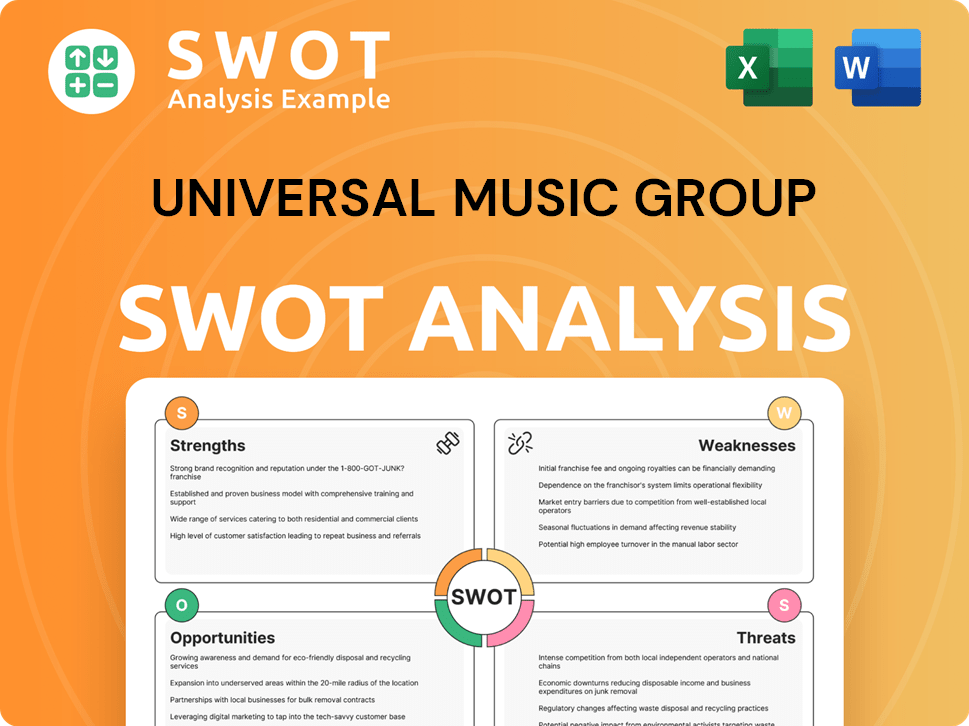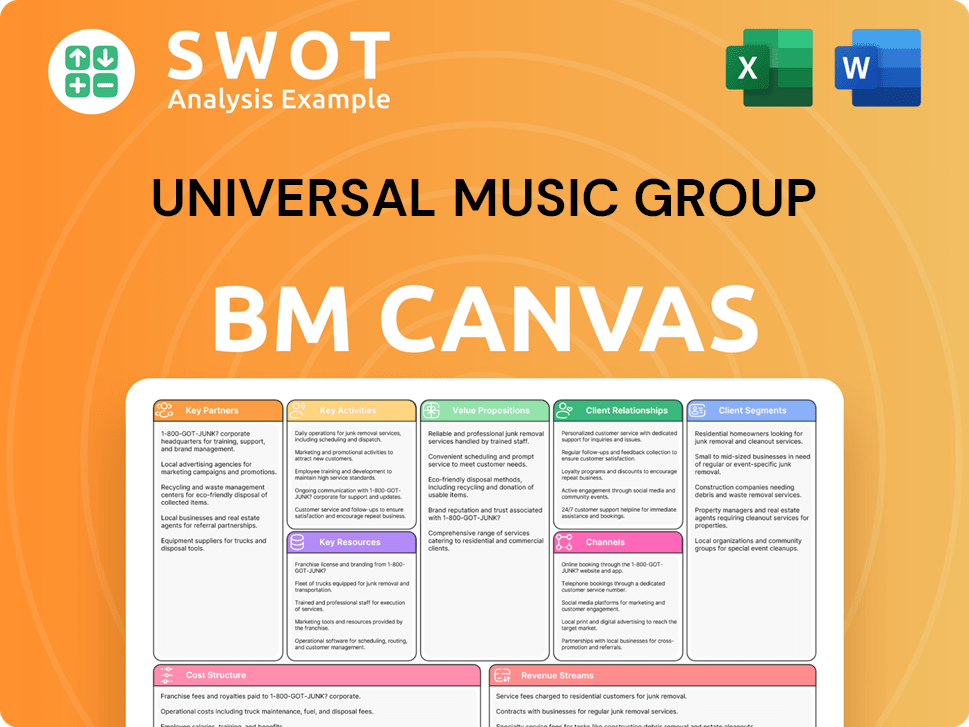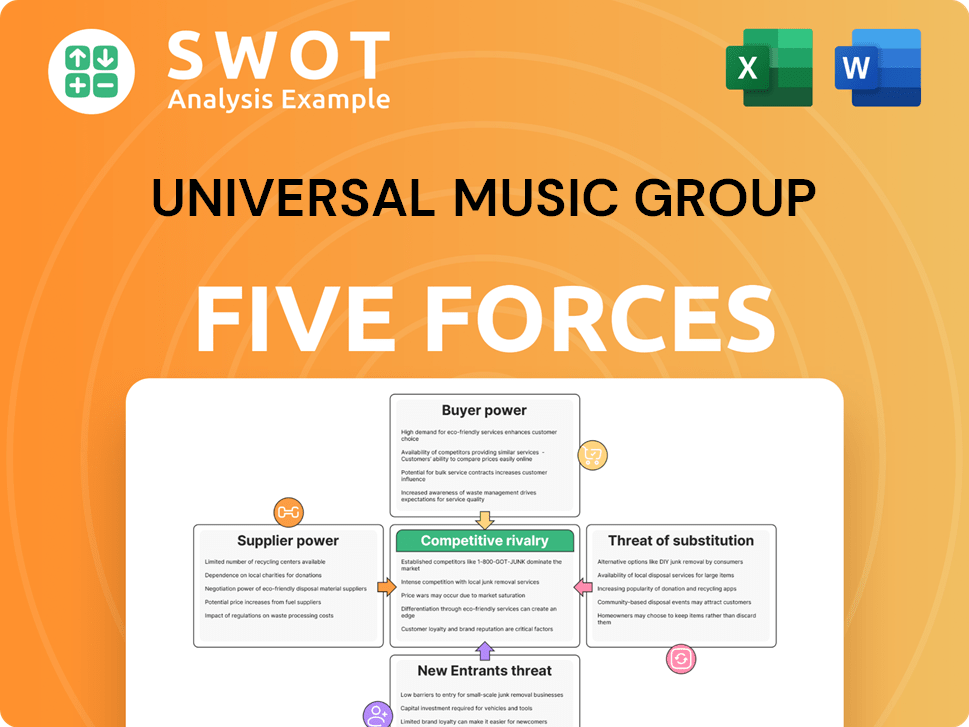Universal Music Group Bundle
How Does Universal Music Group Dominate the Music Scene?
Universal Music Group (UMG), a titan in the music industry, controls a vast empire spanning recorded music, publishing, and more. In 2024, UMG's financial performance was impressive, with revenue soaring to €11.834 billion. Understanding UMG's inner workings is key to grasping its influence and investment potential.

This exploration delves into how this Universal Music Group SWOT Analysis drives its success. We'll examine how the music company identifies and nurtures talent, produces and distributes music, and leverages various monetization strategies, including its relationships with streaming services. From understanding UMG's artist roster and role in music publishing to how it handles royalties, this analysis offers a comprehensive view of a leading player in the music industry, including its impact on the industry and its global presence.
What Are the Key Operations Driving Universal Music Group’s Success?
The core operations of Universal Music Group (UMG), a leading music company, revolve around discovering, developing, and monetizing artists' content globally. UMG provides comprehensive services, including recorded music, music publishing, merchandising, and audiovisual content. This includes state-of-the-art recording facilities, intellectual property rights management, and global distribution through various channels.
UMG's operational processes are designed for efficiency and broad market reach, encompassing robust A&R divisions, extensive production capabilities, and a sophisticated distribution network. The company leverages licensing agreements with major streaming services. These strategies have generated a significant portion of its revenue, with streaming services being a critical distribution channel.
UMG's unique approach and global infrastructure set it apart from competitors. Its extensive catalog, with approximately 5 million songs in its publishing division and 3.4 million recorded music titles in 2024, provides a significant competitive advantage. UMG's ability to combine traditional music production with cutting-edge digital strategies allows it to offer comprehensive artist support, including digital marketing and social media management, which enhances customer benefits and market differentiation.
The recorded music division focuses on signing, developing, and promoting artists. It handles all aspects of music production, from recording to distribution. UMG's distribution network ensures music reaches consumers through various channels, including digital platforms and physical sales.
UMG's music publishing division manages the rights to musical compositions. This includes licensing songs for use in films, television, and advertising. The division also collects royalties on behalf of songwriters and composers.
UMG also engages in merchandising, selling artist-branded products. Additionally, it produces and distributes audiovisual content, expanding its revenue streams. These diverse operations contribute to UMG's comprehensive value proposition.
UMG's global distribution network ensures its music reaches consumers worldwide. Licensing agreements with major streaming platforms, like Spotify and Apple Music, are crucial. Streaming services accounted for 64% of recorded music revenue as of Q2 2023.
UMG's competitive edge lies in its extensive catalog and ability to adapt to digital strategies. Catalog sales accounted for 66% of UMG's recorded music digital and physical revenue in 2024. The company's strong negotiation power with streaming platforms further solidifies its position.
- Extensive Catalog: Approximately 5 million songs in publishing and 3.4 million recorded music titles in 2024.
- Digital Strategy: Combining traditional production with digital marketing.
- Negotiation Power: Ability to increase royalty rates and protect against AI-generated content.
- Global Infrastructure: A worldwide network for distribution and artist support.
To delve deeper into the strategic growth of the music company, you can explore the Growth Strategy of Universal Music Group.
Universal Music Group SWOT Analysis
- Complete SWOT Breakdown
- Fully Customizable
- Editable in Excel & Word
- Professional Formatting
- Investor-Ready Format

How Does Universal Music Group Make Money?
The Universal Music Group (UMG), a leading music company, generates revenue through a multifaceted approach. Its business model is built on diverse revenue streams, including recorded music, music publishing, and merchandising. These streams are enhanced by strategic initiatives and a global presence, ensuring robust financial performance.
UMG's ability to adapt to evolving market dynamics, such as the shift towards digital streaming, and its strategic investments, like the acquisition of Downtown Music Holdings, highlight its commitment to long-term growth and sustainability within the music industry. This approach enables UMG to maximize its revenue potential across various platforms and markets.
In 2024, UMG demonstrated strong financial results, with total revenue reaching €11.834 billion (approximately $12.81 billion USD). This growth reflects the company's successful strategies in a dynamic market. The following sections detail the specific revenue streams and monetization strategies that contribute to UMG's financial success.
Recorded Music is the largest revenue driver for Universal Music Group. This segment includes income from the sale and licensing of recorded music. In 2024, this segment generated €8.901 billion (approximately $9.63 billion USD), up 6.4% year-over-year in constant currency.
- Streaming: Subscription streaming is a major component, with revenues of €4.624 billion (approximately $5.00 billion USD) in 2024, a 9.1% increase year-over-year. Ad-funded streaming contributed €1.414 billion (approximately $1.53 billion USD).
- Physical Sales: Physical sales also contribute to revenue, showing a 1.1% growth in constant currency in 2024.
- Digital Downloads and Licensing: These channels also contribute to the overall revenue, though streaming is the dominant force.
Music Publishing is a significant revenue stream for UMG, focusing on managing songwriters' rights and licensing music. This segment generates income from royalties and licensing fees. In 2024, Music Publishing revenue was €2.121 billion (approximately $2.30 billion USD), an increase of 9.0% year-over-year in constant currency.
- Songwriter Rights Management: UMG manages the rights of songwriters, ensuring they receive royalties for the use of their music.
- Licensing: Licensing music for use in films, television, advertising, and other media generates significant revenue.
- Royalty Collection: UMG collects royalties from various sources, including streaming services, radio, and public performances.
Merchandising and Other revenue includes income from merchandise sales, touring merchandise, and other related activities. This segment has shown substantial growth. In 2024, this segment amounted to €842 million, representing a 19.3% year-over-year growth in constant currency.
- Direct-to-Consumer Sales: Sales of merchandise through direct channels contribute significantly.
- Touring Merchandise: Sales of merchandise at concerts and tours are a key revenue source.
- Other Revenue Streams: This includes various other income sources related to artist activities and brand partnerships.
UMG employs several innovative monetization strategies to maximize revenue and adapt to the changing music landscape. These strategies focus on enhancing artist-centricity and expanding revenue sources. The company's strategic investments, such as the acquisition of Downtown Music Holdings for $775 million in December 2024, further expand its revenue sources by securing rights and offering a broader suite of services to artists and labels.
- Streaming 2.0 Initiative: This initiative aims to evolve the streaming business model to enhance artist-centricity, consumer segmentation, and ARPU growth.
- Catalog Investments: Strategic investments in music catalogs provide long-term revenue streams.
- Artist Services: Offering comprehensive services to artists, including marketing, distribution, and promotion, enhances revenue generation.
- Global Presence: UMG's global operations ensure a diverse revenue mix, with North America accounting for 52% of recorded music revenues in 2024 and Europe representing 28%.
Universal Music Group PESTLE Analysis
- Covers All 6 PESTLE Categories
- No Research Needed – Save Hours of Work
- Built by Experts, Trusted by Consultants
- Instant Download, Ready to Use
- 100% Editable, Fully Customizable

Which Strategic Decisions Have Shaped Universal Music Group’s Business Model?
The story of Universal Music Group (UMG), a leading music company, is marked by significant milestones and strategic maneuvers that have shaped its operations and financial performance. UMG's approach to the music industry has been dynamic, adapting to shifts in technology and consumer behavior. A key strategic move is the 'Streaming 2.0' strategy, launched in 2024, focusing on artist-centric principles to drive innovation and growth in streaming. This strategy includes new agreements with platforms like Amazon and Spotify.
In 2024, UMG significantly increased its catalog acquisition spending, investing €266 million (approximately $288 million USD) to acquire music publishing and recorded music catalogs, a substantial increase from €178 million in 2023. These acquisitions, along with strategic partnerships, have expanded UMG's global reach and strengthened its independent music distribution capabilities. UMG's ability to identify, attract, sign, and retain successful artists and songwriters, including top sellers like Taylor Swift, Billie Eilish, and Morgan Wallen in 2024, further solidifies its market leadership.
UMG faces operational and market challenges, such as foreign exchange headwinds and the need to effectively monetize ad-supported streaming. Despite some reports of flat subscription streaming growth in Q3 2024, UMG has emphasized continued long-term growth and highlighted double-digit revenue growth from four major DSP partners in Q1 2025. The company also addressed a data breach in July 2024, investigating and offering credit monitoring to affected individuals. For more insights, explore the Growth Strategy of Universal Music Group.
UMG's journey is defined by key acquisitions and strategic initiatives. The 'Streaming 2.0' strategy, launched in 2024, is a significant move focusing on artist-centric principles. Acquisitions like Mavin Global and Downtown Music Holdings in 2024 have expanded UMG's global footprint.
UMG's strategic moves include significant investments in catalog acquisitions and partnerships with streaming services. The company focuses on expanding its global presence, particularly in emerging markets. Addressing challenges like data breaches and market fluctuations is also a key part of its strategy.
UMG's competitive advantages are its brand strength, extensive catalog, and economies of scale. The company's vast catalog, with 66% of its recorded music digital and physical revenue in 2024 coming from catalog sales, provides a consistent income stream. UMG's global infrastructure and network enable a streamlined process for discovering, producing, and promoting music.
UMG's financial performance is influenced by its strategic moves and market conditions. Despite some challenges, the company has demonstrated double-digit revenue growth from major DSP partners in Q1 2025. Catalog sales contribute significantly to its revenue, providing a stable income stream.
UMG's strengths lie in its extensive catalog, brand recognition, and ability to attract top artists. The company's global infrastructure and strategic acquisitions further enhance its competitive position in the music industry. These factors contribute to UMG's ability to maintain its market leadership.
- Extensive catalog with a significant contribution from catalog sales.
- Strong relationships with major streaming services.
- Ability to identify and sign successful artists and songwriters.
- Global infrastructure for music discovery, production, and promotion.
Universal Music Group Business Model Canvas
- Complete 9-Block Business Model Canvas
- Effortlessly Communicate Your Business Strategy
- Investor-Ready BMC Format
- 100% Editable and Customizable
- Clear and Structured Layout

How Is Universal Music Group Positioning Itself for Continued Success?
As a leading music company, Universal Music Group (UMG) holds a prominent position in the global music industry, competing with major players like Warner Music Group and Sony Music. UMG's strategic initiatives and market presence significantly influence the industry's dynamics. The company's focus on innovation and global expansion shapes its future trajectory, particularly in response to evolving market trends and technological advancements.
UMG's performance is closely tied to its ability to adapt to industry challenges and capitalize on emerging opportunities. The company's approach to artist development, revenue diversification, and global market penetration will be critical in sustaining its competitive advantage. Understanding these factors is crucial for evaluating UMG's long-term prospects and its impact on the broader music industry.
Universal Music Group maintains a leading position in the global music industry. It competes with major players like Warner Music Group and Sony Music. UMG's extensive portfolio of labels and publishers, coupled with its ability to attract and develop top artists, ensures strong customer loyalty and global reach.
UMG faces several risks, including the potential failure to attract and retain successful artists and the impact of streaming services. Reliance on digital service providers (DSPs) and changes in global economic conditions also pose significant challenges. The rise of generative AI presents a new threat to revenue streams.
UMG anticipates continued revenue growth, driven by an expected 8-10% compound annual growth rate in subscription revenue through 2028. The company is expanding its global reach by investing in local markets, particularly in high-potential markets like India and China. UMG plans to move its primary stock exchange listing to the U.S. in 2025.
UMG held approximately 34% of the global recorded music market share as of 2022. In 2024, North America accounted for 52% of UMG's recorded music revenues, indicating a strong presence in a key market.
UMG is actively pursuing strategic initiatives to sustain and expand its revenue generation. The company is focusing on its 'Streaming 2.0' strategy, aiming to evolve the streaming services business model. UMG is also expanding its global reach through artist investment, local label partnerships, and acquisitions.
- UMG's 'Streaming 2.0' strategy includes efforts to increase royalty rates and protect against AI-generated content.
- The company plans to engage fans in new ways in 2025.
- UMG is investing in high-potential markets like India, the Middle East, West and Sub-Saharan Africa, and Greater China.
- In November 2024, UMG announced its intention to move its primary stock exchange listing to the U.S. in 2025.
Universal Music Group Porter's Five Forces Analysis
- Covers All 5 Competitive Forces in Detail
- Structured for Consultants, Students, and Founders
- 100% Editable in Microsoft Word & Excel
- Instant Digital Download – Use Immediately
- Compatible with Mac & PC – Fully Unlocked

Related Blogs
- What are Mission Vision & Core Values of Universal Music Group Company?
- What is Competitive Landscape of Universal Music Group Company?
- What is Growth Strategy and Future Prospects of Universal Music Group Company?
- What is Sales and Marketing Strategy of Universal Music Group Company?
- What is Brief History of Universal Music Group Company?
- Who Owns Universal Music Group Company?
- What is Customer Demographics and Target Market of Universal Music Group Company?
Disclaimer
All information, articles, and product details provided on this website are for general informational and educational purposes only. We do not claim any ownership over, nor do we intend to infringe upon, any trademarks, copyrights, logos, brand names, or other intellectual property mentioned or depicted on this site. Such intellectual property remains the property of its respective owners, and any references here are made solely for identification or informational purposes, without implying any affiliation, endorsement, or partnership.
We make no representations or warranties, express or implied, regarding the accuracy, completeness, or suitability of any content or products presented. Nothing on this website should be construed as legal, tax, investment, financial, medical, or other professional advice. In addition, no part of this site—including articles or product references—constitutes a solicitation, recommendation, endorsement, advertisement, or offer to buy or sell any securities, franchises, or other financial instruments, particularly in jurisdictions where such activity would be unlawful.
All content is of a general nature and may not address the specific circumstances of any individual or entity. It is not a substitute for professional advice or services. Any actions you take based on the information provided here are strictly at your own risk. You accept full responsibility for any decisions or outcomes arising from your use of this website and agree to release us from any liability in connection with your use of, or reliance upon, the content or products found herein.